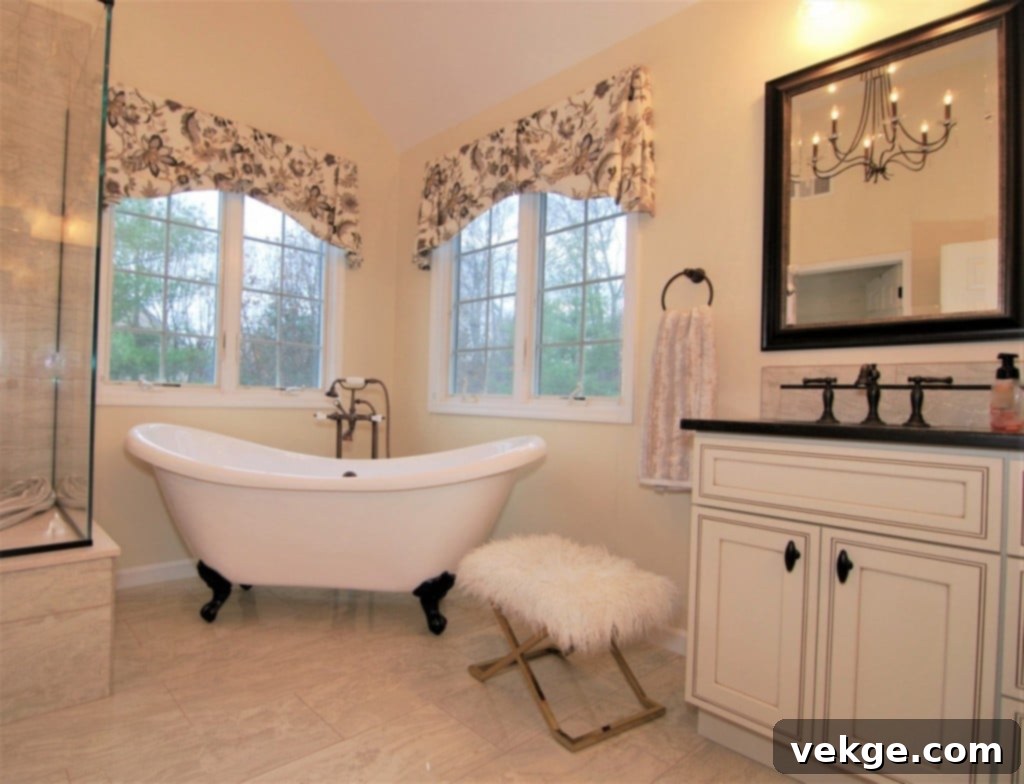Transform Your Bathroom: The Ultimate Guide to French Country Fabrics and Decor
Imagine stepping into a bathroom that transports you straight to the serene, sun-drenched countryside of Provence. A place where every detail whispers elegance, comfort, and a timeless connection to nature. If you cherish your “me” time and dream of a personal sanctuary, then embracing French Country design for your bathroom is an exquisite choice. This beloved style effortlessly blends rustic charm with refined sophistication, creating a space that feels both welcoming and luxurious.
Achieving a French Country aesthetic, especially in a functional space like a bathroom, is more accessible than you might think. Regardless of your geographical location, the key lies in understanding the core aesthetic features and, crucially, selecting the right materials. Fabrics, in particular, play an indispensable role in exuding the authentic warmth and character of a French chateau or farmhouse. From the delicate patterns of toile to the robust texture of linen, textiles can define the mood and bring the entire vision to life.
To successfully recreate this enchanting design, it’s imperative to recognize that the right fabrics are not just decorative; they are foundational to the overall ambiance. They add softness, pattern, and a crucial layer of texture that distinguishes a truly authentic French Country space. This comprehensive guide will walk you through the most popular and appropriate fabrics to use for your French Country bathroom decor, along with practical tips on how to incorporate them seamlessly into your design. Get ready to transform your bathroom into a picturesque escape!
Popular Fabrics to Use in French Country Bathroom Decor
Let’s delve into the specific fabrics that are quintessential to French Country design, offering detailed insights into their characteristics and how you can handpick them to craft your dream bathroom.
1. Tapestry
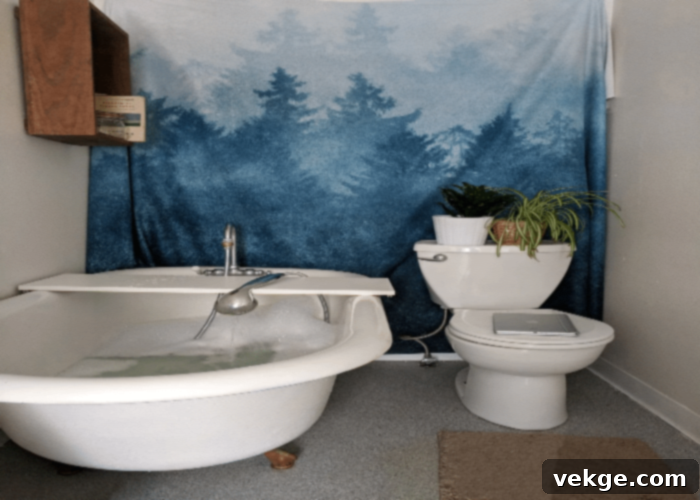
The venerable art of tapestry making boasts a rich history, tracing its origins in Europe back to the mid-14th century. Historically, tapestries were grand statements, adorning the walls of churches, castles, and aristocratic homes, serving both as insulation and magnificent works of art. A tapestry is a meticulously hand-woven cloth, crafted using an array of colored threads to create intricate designs, narratives, or patterns. These elaborate textile art pieces were once reserved for royalty and nobility, symbolizing wealth and status. Today, while still appreciated for their artistry, tapestries find more accessible applications as decorative items, from wall hangings to sophisticated cushion covers and even unique tablecloths.
How can you incorporate tapestry into your French Country design?
Incorporating tapestry into your French Country bathroom decor is a superb way to infuse a sense of historical richness and sophistication. Tapestry curtains are an excellent choice, immediately exuding a luxurious and visually arresting effect. Opt for designs featuring pastoral scenes, botanical motifs, or classic heraldic patterns to align with the French Country aesthetic. Beyond curtains, consider a smaller tapestry as a wall hanging in a less humid area of the bathroom, perhaps above a vanity or beside a window, to serve as a focal point. You could also use tapestry fabric to re-upholster a small vintage stool or bench, adding both comfort and a touch of antique charm. The thick, textured weave of tapestry provides a wonderful contrast to smoother surfaces like porcelain and tile, creating a dynamic and layered look reminiscent of a grand old chateau.
2. Linen
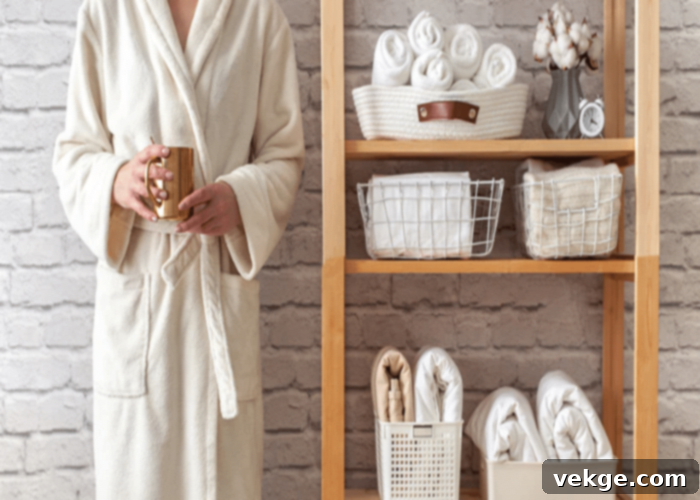
French linen, a textile with an almost mythical status, is crafted by weaving flax fibers into fabric. This highly sought-after material is celebrated not only for its exquisitely smooth and soft texture, which only improves with age, but also for its remarkable sustainability and eco-friendliness. Flax cultivation requires minimal water and pesticides, making it an environmentally conscious choice. Naturally hypoallergenic, breathable, and highly absorbent, French linen is an ideal fabric for many applications. It’s also renowned for its durability and ease of care, making it a practical yet luxurious option. Traditionally used for luxurious bed sheets, duvet covers, sophisticated curtains, and elegant table linens, its versatility is unmatched.
How can you incorporate French linen into your French Country design?
French linen is a cornerstone of the French Country aesthetic, embodying effortless elegance and natural comfort. In your bathroom, French linen can be magnificently incorporated in various ways. Imagine flowing linen curtains gracing your windows, allowing diffused natural light to create a soft, ethereal glow. For an ultimate touch of luxury, consider plush linen bathroom robes and towels, providing both comfort and a refined look. Open shelves can be draped with simple, unadorned linen fabric, adding a casual yet chic element and concealing storage. If your bathroom features a small bench, stool, or a vintage washstand, covering it with a custom-fit linen slipcover or even a simple linen runner can instantly elevate its appearance. Small linen sachets filled with lavender, strategically placed, also contribute to the sensory experience. Its subtle texture and natural drape perfectly complement the rustic, yet polished, vibe of French Country decor, creating a calm and inviting atmosphere.
3. French Ticking
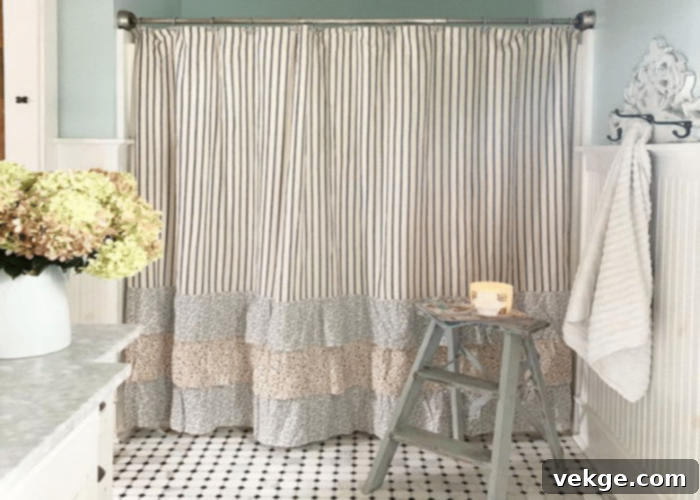
The term ‘ticking’ itself derives from the Latin root tica, meaning ‘casing,’ perfectly reflecting its original purpose. This distinctive fabric, with a history rooted in Nîmes, France, was initially created for making durable covers for mattresses and daybeds. Ticking’s enduring appeal lies in its strength, remarkable durability, and its uniquely appealing striped pattern. Traditionally, it’s a tightly woven fabric, often cotton or linen, characterized by its classic, evenly spaced stripes, typically in muted colors like blue, red, or black against a cream or off-white background. These stripes are not just decorative; they historically indicated the quality and weave of the fabric. Today, French ticking has moved beyond its utilitarian origins and is commonly embraced in upholstery, pillow covers, and a myriad of other home decor projects, cherished for its rustic charm and timeless simplicity.
How can you incorporate French ticking into your French Country decor?
French ticking, with its humble origins and robust character, brings an authentic touch of farmhouse chic to your French Country bathroom. Its classic stripes offer a subtle pattern that complements other elements without overwhelming the space. Consider incorporating French ticking as elegant shower curtains, providing a clean, tailored look. Soft, absorbent towels crafted from French ticking can introduce a charming, rustic element to your linen collection. For a coordinated feel, matching bathrobes made from this durable fabric offer both comfort and style. Beyond these, think about smaller accents: a custom-made French ticking cover for a tissue box, small storage bins, or even a padded seat cushion for a vanity stool. Its understated beauty and resilience make it a perfect fit for a bathroom that balances practicality with the unpretentious elegance of the French countryside.
4. Toile
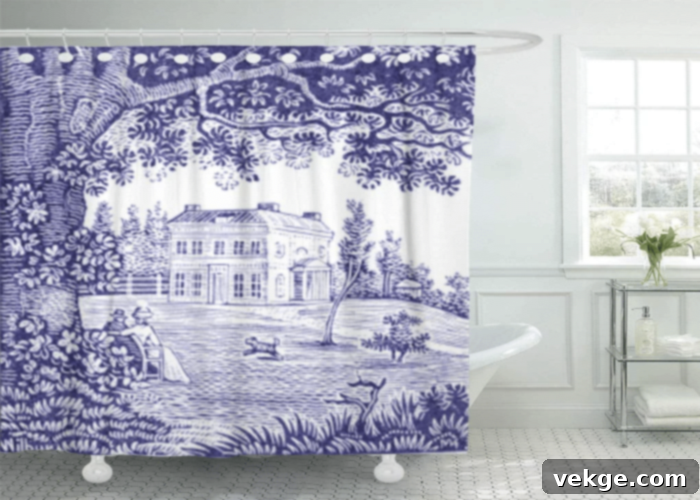
Toile, or more precisely “Toile de Jouy” (fabric from Jouy-en-Josas), is another specialty fabric deeply rooted in French history and design. This iconic fabric has graced French homes since the 18th century, becoming synonymous with pastoral elegance and storytelling. Toile is distinguished less by its material composition (often cotton or linen) and more by its distinctive patterned design. It typically features intricate, repetitive pictorial scenes – often pastoral landscapes, mythological events, or romantic vignettes – printed in a single contrasting color (most commonly blue, red, green, or black) on a light background, such as white, cream, or beige. While muted tones are prevalent, the classic blue and white combination remains eternally popular, evoking a fresh and timeless appeal.
How can you incorporate toile into your French Country design?
Toile brings a narrative quality and a touch of nostalgic romance to any French Country bathroom. Its detailed patterns provide visual interest and a sense of history. Consider incorporating toile through elegant hand-embroidered towels or luxurious bathrobes, offering a subtle nod to French artistry. For a more prominent statement, a custom shower curtain in a beautiful toile print can transform the entire space, acting as a dramatic focal point. You might also use toile fabric for a small valance over a window, or to create decorative throw pillows for a bathroom seating area, if space permits. Even a framed piece of toile fabric can serve as charming wall art. Its ability to tell a story through intricate designs makes toile an ideal choice for creating a bathroom that feels both sophisticated and deeply personal, echoing the charm of the French countryside.
5. Lace
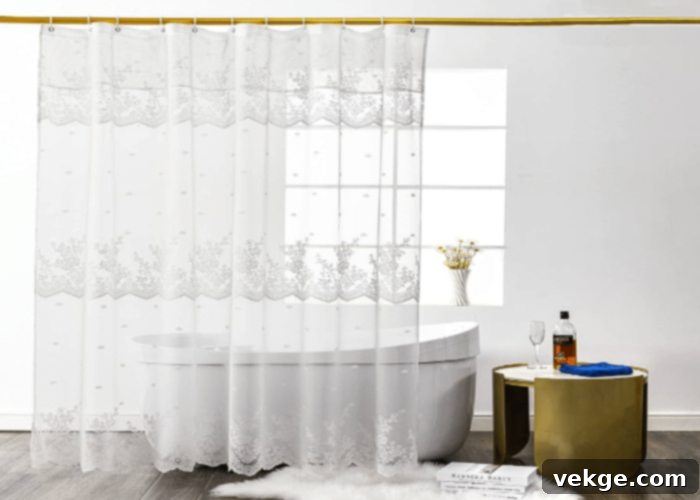
Lace, renowned for its delicate beauty and intricate openwork patterns, is a decorative sheer fabric that adds an unparalleled touch of romance and elegance. Traditionally made from natural fibers such as cotton, silk, wool, or linen, lace fabrics can vary greatly in weight and texture depending on the material and production method. Common types include needle lace, bobbin lace, crochet lace, and tatting, each with its unique characteristic. While often delicate, lace can be blended with synthetic fibers to enhance its durability, making it suitable for a wider range of applications. Popular lace designs frequently feature botanical, geometric, and floral motifs, offering a timeless aesthetic that perfectly complements the soft, feminine touches often found in French Country decor. Its breathable and soft nature adds a textural contrast and a layer of visual lightness to any space.
How can you incorporate lace into your French Country design?
Lace is an exquisite choice for introducing subtle refinement and vintage charm into your French Country bathroom. Its delicate nature and intricate patterns can soften the utilitarian aspects of the space, creating a more inviting and ethereal atmosphere. Consider using beautiful lace window curtains or sheer panels to filter natural light, casting graceful shadows and enhancing privacy without blocking the light entirely. A lace-trimmed shower curtain can add a touch of antique elegance, especially when paired with a simple linen or cotton base. Beyond curtains, lace can be used for smaller, more intimate details: elegant lace doilies on a vanity, a delicate lace trim added to plain towels, or even a piece of framed lace artwork. A vintage lace runner draped over a small chest of drawers or a shelf can also add a charming, textural layer. Embrace lace to infuse your bathroom with a sense of romantic nostalgia and timeless French allure.
Some Other Essential Elements for French Country Decor
While fabrics are paramount, a truly authentic French Country bathroom relies on a harmonious blend of various elements. Here’s what more you can do to replicate the enchanting spirit of the French countryside in your private sanctuary:
- Instill a Sink with Floral Engraving: Elevate your washing area with a gorgeous sink featuring delicate botanical engravings. This artistic touch instantly adds a sense of artisanal craftsmanship and natural beauty. Pair this stunning basin with a classic brass or aged bronze faucet for an antique feel, and complete the look with a natural marble countertop, which adds both luxury and durability.
- Vintage Wood Bathroom Vanity: A substantial, vintage wood bathroom vanity serves as a magnificent anchor for your French Country design. Look for pieces with distressed finishes, intricate carvings, or a repurposed antique dresser. A double-sink vanity is both practical and grand. Complement this with a large, ornate mirror, perhaps with a cream-colored, gilded, or antique gold frame, to reflect light and add an aristocratic touch.
- Embrace Wicker and Woven Baskets: The use of natural materials is central to French Country style. Place a charming wicker basket by the toilet to hold extra toilet paper rolls, or use larger woven baskets for neatly storing towels, bath linens, or even laundry. These elements add texture, warmth, and a casual, rustic elegance that screams French farmhouse charm.
- Bathtub with Gold Hardware and Clawfoot Design: For the ultimate statement, a luxurious clawfoot tub is indispensable. Imagine an all-white marble bathroom as a serene backdrop for such a tub, adorned with elegant gold hardware fixtures for the faucet and showerhead. This combination exudes opulence and vintage glamour. Complete the setup with a round wall mirror framed in gold and a tall, antique wood armoire for storage, bringing both functionality and classic beauty.
- Aromatic Touches with Lavender and Botanicals: French Country style is deeply connected to nature. Introduce fresh or dried lavender bundles, known for their calming scent and iconic association with Provence. Small potted herbs like rosemary or mint, or elegant floral arrangements in vintage pitchers or vases, will add living elements and delightful fragrances, enhancing the sensory experience of your peaceful retreat.
- Charming Lighting Fixtures: Lighting plays a crucial role in setting the mood. Opt for vintage-inspired sconces with a brushed brass or wrought iron finish, or a small crystal chandelier for a touch of refined sparkle. Avoid harsh, modern lighting; instead, aim for warm, diffused illumination that enhances the room’s soft and inviting ambiance.
Concluding Thoughts
You now possess a comprehensive understanding of how to select and incorporate the right fabrics to craft a truly authentic and enchanting French Country bathroom. Remember, the goal is to infuse your space with a sense of rustic elegance, timeless charm, and the comfortable sophistication of the French countryside. The fabrics discussed – Tapestry, Linen, French Ticking, Toile, and Lace – are not merely decorative elements; they are vital components that build texture, pattern, and soul into your design. They provide the softness, visual interest, and historical depth that define this cherished style.
It’s important to reiterate that to achieve the desired aesthetic touch, you don’t necessarily need to source fabrics directly from France. The essence lies in choosing materials that embody the spirit and characteristics frequently employed by French designers in their interior and bathroom decor – natural fibers, classic patterns, and a palette that evokes serenity. By carefully selecting these textiles and complementing them with vintage-inspired furniture, natural elements, and thoughtful accents, you can transform your bathroom into a serene retreat worthy of a French chateau.
Hopefully, as you embark on your bathroom decor project, drawing inspiration from French Country-style bathrooms, you will find our guide invaluable for choosing the perfect fabrics and exuding that coveted, harmonious look. We invite you to share your thoughts, ideas, and even your finished French Country bathroom creations in the comments section below – we’d love to hear from you!
Frequently Asked Questions
What is French Country Fabric?
French Country fabric refers to textiles that embody the relaxed elegance and rustic charm of the French countryside. Key characteristics include natural fibers like cotton and linen, muted color palettes, and specific patterns that reflect rural life or traditional French motifs. Toile is perhaps the most iconic example, featuring intricate pastoral scenes or mythological figures printed in a single color on a light background. French ticking, with its distinctive stripes, and soft, natural linen are also quintessential French Country fabrics, providing texture, durability, and a sense of timeless simplicity.
What Fabric is France Known For?
France is particularly renowned for its exquisite French linen. This specially cultivated fabric is prized for its exceptional strength, durability, and classic, soft drape that only improves with age. French linen is produced by interweaving flax fibers into textiles, a process deeply rooted in French agricultural tradition. It is highly sought after by French interior designers and homemakers alike for its ability to create that perfect rustic yet refined look, whether in bedding, apparel, or elegant home furnishings. Beyond linen, France is also historically famous for its silk production, particularly from Lyon, and its role in popularizing fabrics like Toile de Jouy.
What Colors Are Best for a French Country Bathroom?
The ideal color palette for a French Country bathroom is inspired by the natural landscapes of Provence – soft, muted, and inviting. Think warm whites, creamy ivories, and subtle beiges for walls and large surfaces, providing a serene backdrop. Accents can introduce soft blues (like sky blue or dusty periwinkle), sage greens, lavender, pale yellows (like buttercup or provence yellow), and occasional earthy reds or terracotta tones. These colors evoke a sense of calm and bring the essence of the French countryside indoors, creating a bright yet comforting atmosphere.
